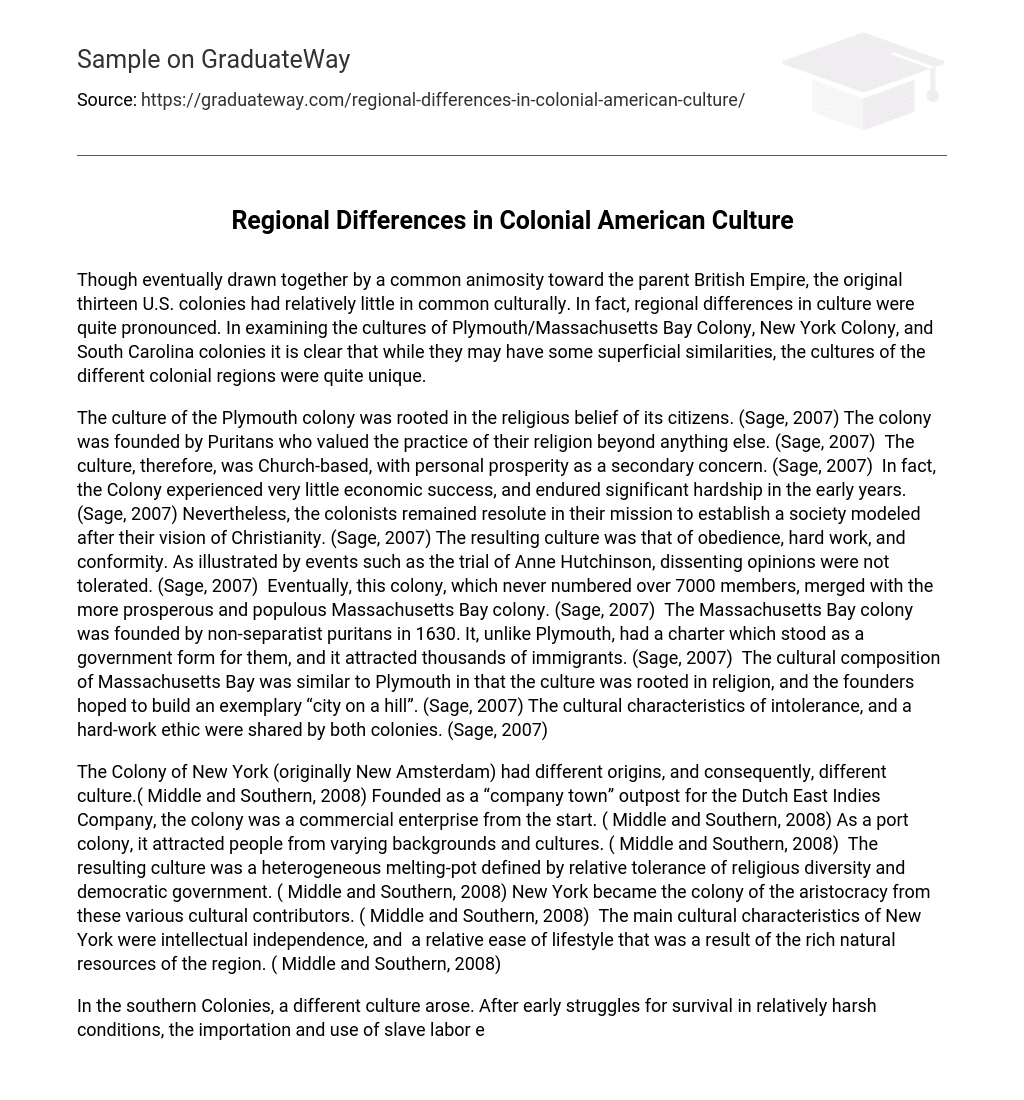Though eventually drawn together by a common animosity toward the parent British Empire, the original thirteen U.S. colonies had relatively little in common culturally. In fact, regional differences in culture were quite pronounced. In examining the cultures of Plymouth/Massachusetts Bay Colony, New York Colony, and South Carolina colonies it is clear that while they may have some superficial similarities, the cultures of the different colonial regions were quite unique.
The culture of the Plymouth colony was rooted in the religious belief of its citizens. (Sage, 2007) The colony was founded by Puritans who valued the practice of their religion beyond anything else. (Sage, 2007) The culture, therefore, was Church-based, with personal prosperity as a secondary concern. (Sage, 2007) In fact, the Colony experienced very little economic success, and endured significant hardship in the early years. (Sage, 2007) Nevertheless, the colonists remained resolute in their mission to establish a society modeled after their vision of Christianity. (Sage, 2007) The resulting culture was that of obedience, hard work, and conformity. As illustrated by events such as the trial of Anne Hutchinson, dissenting opinions were not tolerated. (Sage, 2007) Eventually, this colony, which never numbered over 7000 members, merged with the more prosperous and populous Massachusetts Bay colony. (Sage, 2007) The Massachusetts Bay colony was founded by non-separatist puritans in 1630. It, unlike Plymouth, had a charter which stood as a government form for them, and it attracted thousands of immigrants. (Sage, 2007) The cultural composition of Massachusetts Bay was similar to Plymouth in that the culture was rooted in religion, and the founders hoped to build an exemplary “city on a hill”. (Sage, 2007) The cultural characteristics of intolerance, and a hard-work ethic were shared by both colonies. (Sage, 2007)
The Colony of New York (originally New Amsterdam) had different origins, and consequently, different culture.( Middle and Southern, 2008) Founded as a “company town” outpost for the Dutch East Indies Company, the colony was a commercial enterprise from the start. ( Middle and Southern, 2008) As a port colony, it attracted people from varying backgrounds and cultures. ( Middle and Southern, 2008) The resulting culture was a heterogeneous melting-pot defined by relative tolerance of religious diversity and democratic government. ( Middle and Southern, 2008) New York became the colony of the aristocracy from these various cultural contributors. ( Middle and Southern, 2008) The main cultural characteristics of New York were intellectual independence, and a relative ease of lifestyle that was a result of the rich natural resources of the region. ( Middle and Southern, 2008)
In the southern Colonies, a different culture arose. After early struggles for survival in relatively harsh conditions, the importation and use of slave labor engendered a stratified society of Aristocratic Plantation owners, poor white farmers, and black slaves. ( Middle and Southern, 2008) More than any other region, the South emphasized the cultural differences of the “haves” versus the “have-nots”. ( Middle and Southern, 2008) The rich plantation owners and their families maintained a culture of exclusivity, genteel manners and a “benevolent” relationship to slaves. ( Middle and Southern, 2008) They saw themselves as the rightful masters of both the land and the black laborers. In contrast, the poor white farmers, which represented a majority of the white southern population, were mostly defined as a close-to-the-earth, hard-working, and self-sufficient culture. ( Middle and Southern, 2008)
Each of these colonies had unique cultures, which made their banding together against the British Crown particularly remarkable. The Massachusetts Bay Colony, with it’s religious structure and culture was very different than the aristocracy of South Carolina. Despite that fact, both cultures professed a belief in Christian Principles, and both had a sense of entitlement from God. The Middle Colonies, not unlike the colonies of New England, focused on commercial gain, albeit for different reasons. While the Puritans to their north sought material gain as proof of God’s favor, the culture of the middle colonies, such as New York, sought wealth for its own sake. In all three regions, the wealthy were well-regarded, albeit for differing reasons. Wealthy individuals in the South were considered cultural elite, in the middle colonies they were commercial elite, and in the New England region, they were religious elite.
With respect to religion, the cultures of these colonies had different approaches. The Culture of Massachusetts Bay was religion-centered. It was a concerted attempt to crate a perfect Christian society. In New York, owing to the diversity of the population, and the focus on fiscal activities, religion did not have a central role. Nearly everyone practiced one form or another of Christianity, but culturally, the religion failed to produce any overweening cultural characteristics in New York. In South Carolina, the aspect of large-scale slavery had interesting implications with respect to religion. The aristocratic elite felt that it was their religious and moral responsibility to care for the “lesser beings” who worked the land for them. ( Middle and Southern, 2008) The poor farmers of South Carolina and other southern colonies clung to religion as a refuge from the hardship of their daily labor. Interestingly, many African slaves did the same thing. ( Middle and Southern, 2008)
It is clear from the examination of the cultures of Massachusetts Bay, New York, and South Carolina that the different regions of the American colonies were very diverse. Despite these differences, the colonies were able to band together to ultimately overthrow the British government and establish a single, united nation.
References
Sage, H. (2007) “The Puritans of New England”, Retrieved October 24th, 2008 from Academic American Website:
http://academicamerican.com/colonial/topics/puritannewengland.html
“The Middle and Southern Colonies.” (2008) Retrieved October 24th, 2008 from Academic American Website:
http://academicamerican.com/colonial/topics/middle.html





